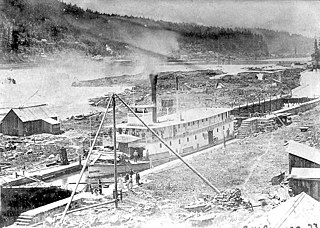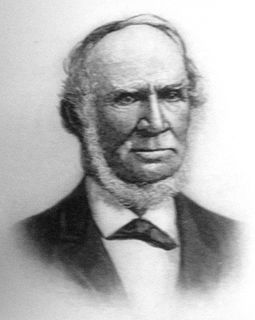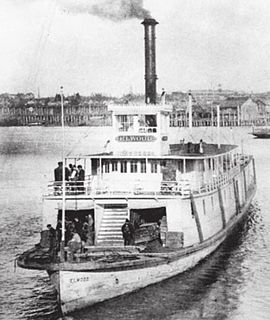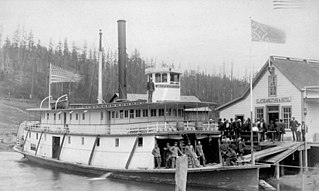
The T.J. Potter was a paddle steamer that operated in the Northwestern United States. The boat was launched in 1888. Her upper cabins came from the steamboat Wide West. This required some modification, because the T.J. Potter was a side-wheeler, whereas the Wide West had been a stern-wheeler. The boat's first owner was the Oregon Railway and Navigation Company. The T. J. Potter was one of the few side-wheeler boats that operated on the Columbia River.

Many steamboats operated on the Columbia River and its tributaries, in the Pacific Northwest region of North America, from about 1850 to 1981. Major tributaries of the Columbia that formed steamboat routes included the Willamette and Snake rivers. Navigation was impractical between the Snake River and the Canada–US border, due to several rapids, but steamboats also operated along the Wenatchee Reach of the Columbia, in northern Washington, and on the Arrow Lakes of southern British Columbia.

The Willamette River flows northwards down the Willamette Valley until it meets the Columbia River at a point 101 miles from the Pacific Ocean, in the U.S. state of Oregon.

The Coquille River starts in the Siskiyou National Forest and flows hundreds of miles through the Coquille Valley on its way to the Pacific Ocean. Bandon, Oregon, sits at the mouth of the Coquille River on the Pacific Ocean. Before the era of railroads and later, automobiles, the steamboats on the Coquille River were the major mode of transportation from Bandon to Coquille and Myrtle Point in southern Coos County, Oregon, United States.

Lurline was a steamboat that served from 1878 to 1930 on the Columbia and Willamette rivers. Lurline was a classic example of the Columbia river type of steamboat.

R. R. Thompson was a large sternwheel steamboat designed in the classic Columbia River style. She was named after Robert R. Thompson, one of the shareholders of the Oregon Steam Navigation Company, the firm that built the vessel.

The sidewheeler Idaho was a steamboat that ran on the Columbia River and Puget Sound from 1860 to 1898. There is some confusion as to the origins of the name; many historians have proposed it is the inspiration for the name of the State of Idaho. Considerable doubt has been cast on this due to the fact that it is unclear if the boat was named before or after the idea of 'Idaho' as a territory name was proposed. John Ruckel also allegedly stated he had named the boat after a Native American term meaning 'Gem of the Mountains' he got from a mining friend from what is now Colorado territory. This steamer should not be confused with the many other vessels of the same name, including the sternwheeler Idaho built in 1903 for service on Lake Coeur d'Alene and the steamship Idaho of the Pacific Coast Steamship Line which sank near Port Townsend, Washington.

Gazelle was an early sidewheeler on the Willamette River in what is now the U.S. state of Oregon. She did not operate long, suffering a catastrophic boiler explosion on April 8, 1854, less than a month after her trial voyage. This was the worst such explosion ever to occur in the Pacific Northwest states. The wrecked Gazelle was rebuilt and operated for a few years, first briefly as the unpowered barge Sarah Hoyt and then, with boilers installed, as the steamer Señorita. A victim of the explosion was D.P. Fuller, age 28, who is buried in Lone Fir Cemetery in Portland, Oregon.

Willamette Chief was a sternwheel steamboat built in 1874 for the Willamette River Navigation Company.

Joseph Kellogg was a well-known steamboat captain and businessman of Portland, Oregon.

The river sternwheeler Ramona operated from 1892 to 1908 on the Willamette River in Oregon, on the Stikine River running from Wrangell, Alaska into British Columbia, and the Fraser River, in British Columbia. This vessel should not be confused with the coastal steamship Ramona which also ran in Alaskan waters.

Sarah Dixon was a wooden sternwheel-driven steamboat operated by the Shaver Transportation Company on the Columbia and lower Willamette rivers from 1892 to 1926. Originally Sarah Dixon was built as a mixed use passenger and freight vessel, and was considered a prestige vessel for the time.

Emma Hayward commonly called the Hayward, was a steamboat that served in the Pacific Northwest. This vessel was once one of the finest and fastest steamboats on the Columbia River and Puget Sound. As newer vessels came into service, Emma Hayward was relegated to secondary roles, and, by 1891, was converted into a Columbia river tow boat.

Elwood was a sternwheel steamboat which was built to operate on the Willamette River, in Oregon, but which later operated on the Lewis River in Washington, the Stikine River in Canada, and on Puget Sound. The name of this vessel is sometimes seen spelled "Ellwood". Elwood is probably best known for an incident in 1893, when it was approaching the Madison Street Bridge over the Willamette River in Portland, Oregon. The bridge swung open to allow the steamer to pass. However, a streetcar coming in from the east end of the bridge failed to notice the bridge was open, and ran off into the river in the Madison Street Bridge disaster.

Jennie Clark, also seen spelled Jenny Clark, was the first sternwheel-driven steamboat to operate on the rivers of the Pacific Northwest, including British Columbia. This vessel was commonly known as the Jennie when it was in service. The design of the Jennie Clark set a pattern for all future sternwheel steamboats built in the Pacific Northwest and in British Columbia.

Shoo Fly was a sternwheel-driven steamboat that operated on the Willamette and Columbia rivers in the 1870s. Originally built as primarily as a freight boat, the vessel was used in other roles, including towing and clearing of snags. Shoo Fly inspired the name of another sternwheeler on the Willamette River, Don't Bother Me.

No Wonder was a stern-wheel driven steamboat that operated on the Willamette, Columbia and Cowlitz rivers from 1889 to 1930. No Wonder was originally built in 1877 as Wonder, which was dismantled in 1888, with components being shifted over to a new hull, which when launched in late 1889 was called No Wonder.

Manzanillo was a stern-wheel driven steamboat built at Portland, Oregon in 1881. Manzanillo was first run on the Columbia River route from Portland to Clatskanie, Oregon and way points along the river. The initial owner of the boat was the People's Freighting Company, but the Shaver family soon acquired control of the vessel, which became the first vessel of what is now Shaver Transportation Company.

Orient was a light-draft sternwheel-driven steamboat built in 1875 for the Willamette River Transportation Company, a concern owned by pioneer businessman Ben Holladay. Shortly after its completion, it was acquired by the Oregon Steam Navigation Company. Orient was a near-twin vessel of a steamer built at the same time, the Occident.

Undine was a sternwheel-driven steamboat that operated from 1887 to 1935 on the Columbia and lower Willamette rivers. From 1935 to 1940 the same vessel was operated under the name The Dalles.





















